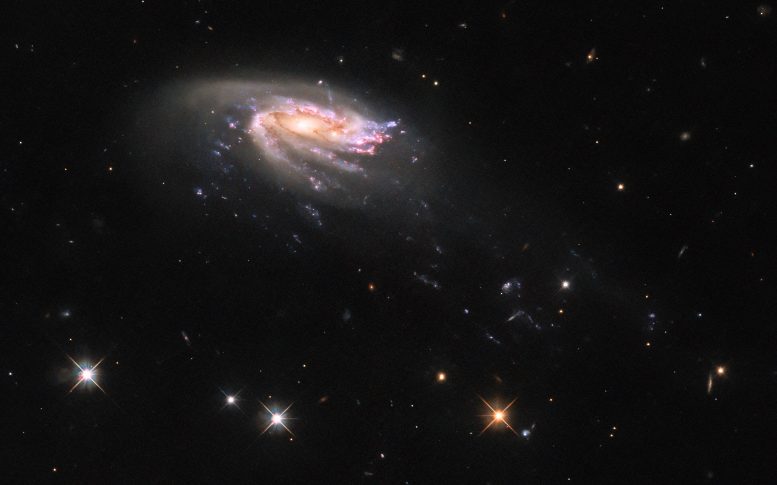El Telescopio Espacial Hubble de NASA/ESA ha capturado una imagen sorprendente de la galaxia de las medusas JO206, ubicada a más de 700 millones de años luz de distancia en la constelación de Acuario. Esta imagen marca la última de una serie de observaciones de galaxias medusas, llamadas así por su forma distintiva, que se asemeja a una medusa con zarcillos de formación estelar. Crédito: ESA/Hubble & NASA, M. Gulleiuszik y el equipo GASP
EL[{» attribute=»»>Hubble Space Telescope has released its final image in a series of jellyfish galaxies, showcasing JO206 in the Aquarius constellation. Named for their resemblance to jellyfish, these galaxies have tendrils of star formation caused by interaction with intra-cluster medium in galaxy clusters. Hubble’s findings suggest that environmental conditions minimally affect star formation, as evident from the similarities between star formations in the galaxy’s main disc and its tendrils.
The jellyfish galaxy JO206 trails across this image from the Hubble Space Telescope, showcasing a colorful star-forming disc surrounded by a pale, luminous cloud of dust. A handful of bright stars with criss-cross diffraction spikes stand out against an inky black backdrop at the bottom of the image. JO206 lies over 700 million light-years from Earth in the constellation Aquarius, and this image of the galaxy is the sixth and final instalment in a series of observations of jellyfish galaxies. Some of Hubble’s other observations of these peculiar galaxies — which range from grandiose to ghostly — are available here.
Jellyfish galaxies are so-called because of their resemblance to their aquatic namesakes. In this image, the disc of JO206 is trailed by long tendrils of bright star formation that stretch towards the bottom right of this image, just as jellyfish trail tentacles behind them. The tendrils of jellyfish galaxies are formed by the interaction between galaxies and the intra-cluster medium, a tenuous superheated plasma that pervades galaxy clusters. As galaxies move through galaxy clusters they ram into the intracluster medium, which strips gas from the galaxies and draws it into the long tendrils of star formation.
The tentacles of jellyfish galaxies give astronomers a unique opportunity to study star formation under extreme conditions, far from the influence of the main disc of the galaxy. Surprisingly, Hubble revealed that there are no striking differences between star formation in the discs of jellyfish galaxies and star formation in their tentacles, which suggests the environment of newly-formed stars has only a minor influence on their formation.
También te puede interesar
-
Encuesta de tránsito de exoplanetas (PETS) de PEPSI. V: Los nuevos espectros de transmisión de Na D indican una atmósfera más tranquila en HD 189733b
-
Las imágenes de alta velocidad y la IA nos ayudan a comprender cómo funcionan las alas de los insectos
-
Tarta de chocolate y sueños marcianos: el helicóptero Ingenuity se despide agridulce | Noticias científicas
-
Brillantes auroras iluminan a los fotógrafos del sur
-
Nuevo descubrimiento: algas y bacterias se fusionan para formar un solo organismo en un laboratorio | Noticias científicas

